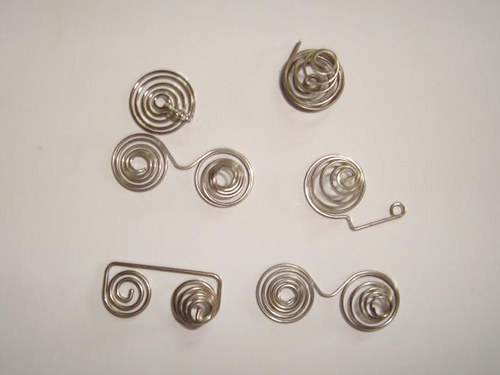4Company dynamics

The choice of spring material should be determined according to factors such as the nature of the spring's load, the state of stress, the magnitude of the stress, the working temperature, the environmental medium, the service life, the requirements for conductive and magnetic conductivity, process performance, material sources and spring price.
When determining the shape and size of the material section, the series of sizes specified by national standards and ministerial standards should be selected first, and materials with non-standard series specifications should be avoided as far as possible.
Small and medium-sized springs, especially spiral tension springs, should be given priority to steel wires that have been strengthened, lead bath isothermal cold drawn steel wires and oil-quenched tempered steel wires, which have higher strength and good surface quality, and their fatigue performance is higher than that of ordinary quenching. Tempered steel wire, simple processing, good manufacturability and stable quality.
How to choose the spring material correctly?
Carbon spring steel wire and piano wire produce large residual stress after cold drawing. After processing the spring, there is a large residual stress. After tempering, the size changes greatly, and it is difficult to control the dimensional accuracy. Oil-quenched and tempered steel wire is modulated and strengthened after the steel wire is drawn to the specified size. There is basically no residual stress. After the spring is formed, it is tempered at low temperature, the size change is small, and the heat resistance stability is better than cold drawn Strengthen the steel wire.
Large and medium-sized springs, cold-drawn or cold-drawn polished steel should be used for high load accuracy and stress. For springs with lower load accuracy and stress, hot rolled steel can be used.
The material cross-section of the coil spring should preferably be a circular cross-section. Square and rectangular cross-section materials have strong bearing capacity, good impact resistance, and can miniaturize the spring, but there are few sources of materials. And the price is high, except for special needs, generally try not to choose this material. In recent years, the development of flattened round steel wire instead of trapezoidal steel wire has achieved good results.
Spring materials that work at high temperatures require good thermal stability, resistance to relaxation or creep, resistance to oxidation, and resistance to certain medium corrosion.
As the working temperature of the spring increases, the elastic modulus of the spring material decreases, resulting in a decrease in stiffness and a decrease in load-bearing capacity. Therefore, the spring working at high temperature must understand the change rate (value) of the elastic modulus, and calculate the impact of the drop in the load capacity of the spring on the performance. According to the regulations of GB1239, when the working temperature of ordinary coil spring exceeds 60℃, the shear modulus should be corrected. The formula is: Gt=KtG where G is the modulus of elasticity at room temperature; Gt is the shear modulus at working temperature t Variable modulus; Kt——The temperature correction coefficient is selected according to 2-98.
The spring material used at low temperature should have good low temperature toughness. Carbon spring steel wire, piano steel wire and austenitic stainless steel spring steel wire such as 1Cr18Ni9, copper alloy and nickel alloy have good low temperature toughness and strength.
At low temperatures, the brittleness of the material is very sensitive to surface defects. Therefore, the surface quality of the material should be strictly required.
At low temperatures, the environmental media will corrode the material much less than in the greenhouse, and cadmium and zinc plating can easily cause cold embrittlement.
At low temperatures, the elastic modulus and expansion coefficient of the material does not change much, so it can be ignored in the design.
